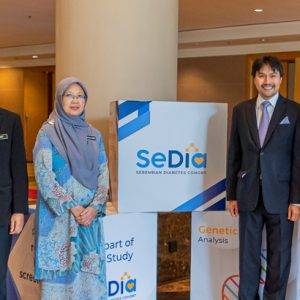Conventionally, trained pathologists view tissue slides under a microscope. In the past decade, pathology has begun to undergo a true digital transformation moving away from analog into an electronic environment. Of late, digital pathology which is a sub-field of pathology has emerged as an important routine diagnostic method replacing the conventional microscope viewing of glass slides.
As its name implies, digital pathology involves converting glass slides into digital slides after being captured with a specialised scanning device. High-resolution digital images that can be viewed, managed, shared, and analysed on a computer monitor are subsequently produced. Digital pathology incorporates the acquisition, management, sharing and interpretation of pathology information in a digital environment. It enables pathologists to engage, evaluate, and collaborate rapidly and remotely, and thus improving efficiency and productivity. Ultimately, digital pathology helps tremendously in achieving efficient and cheaper diagnoses, prognosis, and more accurate prediction of diseases.
The Institute for Research, Development and Innovation (IRDI) of the International Medical University (IMU) in collaboration with MMU-UKM-IMU Artificial Intelligence for Digital Pathology (AI4DP) consortium had successfully organised Digital Pathology Congress: Malaysia – National Policy on the Development and Use of Digital Pathology Technology. It was a two-day event which was conducted in hybrid mode from 25 August 2022 to 26 August 2022.
Held in conjunction with the IMU Digital Health Week, the congress was organised to instil the importance of digital pathology and its implication towards the society, update on the development of digital pathology, as well as create digital health awareness, particularly about digital pathology amongst the audience.
| The first day of the congress was lined up by a series of talks by three prominent speakers: |
|---|
| Prof Dr Nor Hayati Othman, President of the International Academy of Pathology (Malaysian Division) |
| Deliberating on the current and future perspectives of digital pathology (Keynote Speech) |
| Prof Dr Nasir M Rajpoot, Director of Tissue Image Analytics (TIA) Centre of University of Warwick, United Kingdom |
| Sharing on artificial intelligence in digital pathology and its future direction |
| Prof Dr Mohammad Faizal Ahmad Fauzi from Multimedia University, Head of A14DP Consortium |
| Introduced the MMU-UKM-IMU Artificial Intelligence for Digital Pathology (AI4DP) Consortium |
The morning session was concluded with a pitching session on potential digital pathology research projects by the participants.
The highlight of the congress was a roundtable discussion or policy dialogue among the invited participants on the direction and needs of digital pathology national guidelines. Various stakeholders from the Ministry of Health (MOH) Malaysia, relevant professional bodies, institutions of higher learning, and civil and customer associations were present. It was anticipated that appropriate recommendations on digital pathology would be made available for various authorities and interested parties at the end of the discussion.
There were three sessions in the roundtable discussion.
| Session 1 of Roundtable Discussion |
|---|
| Introduction of digital pathology landscape in Malaysia with Prof Dr Nor Hayati Othman, President of International Academy of Pathology (Malaysian division) deliberating on the current practice and challenges of implementation of digital pathology in Malaysia. |
| Session 2 of Roundtable Discussion | |
|---|---|
| Experience sharing session by international partners. | |
| Topics covered | Best Practice for the Implementation of Digital Workflow in a Clinical Setting Applications of Artificial Intelligence in Digital Pathology Development of Digital Pathology and Artificial Intelligence Tools in Clinical and Research Settings Digital Pathology: The Pathologist’s Perspective. |
| Speakers include | Prof Dr Inti Zlobec from University of Bern (Switzerland), Prof Dr Nasir M Rajpoot from University of Warwick (United Kingdom), A/Prof Dr Andrew Janowczyk from Geneva University Hospital (Switzerland), and Prof Dr David Snead from University Hospitals Coventry and Warwickshire (United Kingdom |
| Session 3 of Roundtable Discussion | |
|---|---|
| Primarily to explore the way forwards of digital pathology in Malaysia | |
| Main topics of discussion were about the implementation of digital pathology from the perspectives of MOH Malaysia, general practitioners, private hospitals, pathologists, as well as the vendors | |
| Speakers | Dr Tengku Norita Binti Tengku Yazid, Head of Pathology Services from MOH Malaysia; Dr Koh Kar Chai, President of Malaysian Medical Association; Dr Zanariah Binti Alias, Head of Pathology Department at Hospital Kuala Lumpur; Eddie Lau Chan Ming, Business Development Manager of Innovz Sdn Bhd. |
Subsequently, the second day of the congress consisted of three hands-on workshops.
Hands-on Workshops

| Histopathology slide preparation by Prof Wong Shew Fung from IMU |
| Whole slide scanning by 3DHistech Company |
| Whole slide image analytics by Prof Dr Nasir M Rajpoot |
The congress yielded fruitful discussions whereby insightful viewpoints and suggestions were shared amongst the stakeholders. Inevitably, digital pathology is very helpful as it can diagnose cases within cases. Nevertheless, many key challenges still prevail, and it comes down to the fact whether our country is ready for the full stretch of digital pathology.
The workflow system has to be integrated and built in such a way which is seamless. The main issue of cost-effectiveness has to be put into consideration as it is costly to digitalise glass slides. Besides, massive investments are required to afford state-of-the-art laboratory equipment and infrastructure. It is also essential to have good internet connection and this is still lacking in many remote places in Malaysia. Also, pathologists will have to undergo sub-specialty training to be equipped with the specialty knowledge. In addition, ethical issues are also a big concern in digital pathology as it will involve sharing of patient data and images. Clear governance of patient data should be in place to protect the data security and integrity as well as patient privacy.
Most importantly, there should be a change of mindset among the pathologists and patients to get rid of the fear of changes but accept digital pathology. On top of all, there is a need for the MOH to formulate clear policy guidelines and blueprints on digital pathology for its effective implementation.
Related article: IMU: Advancing the Digital Health Industry in Malaysia









